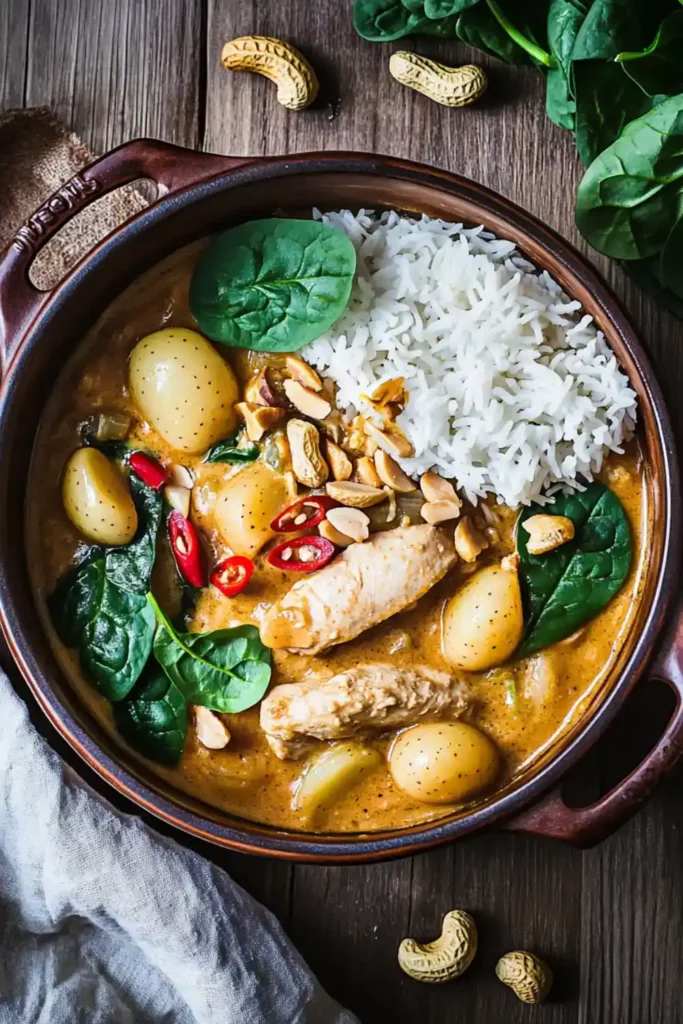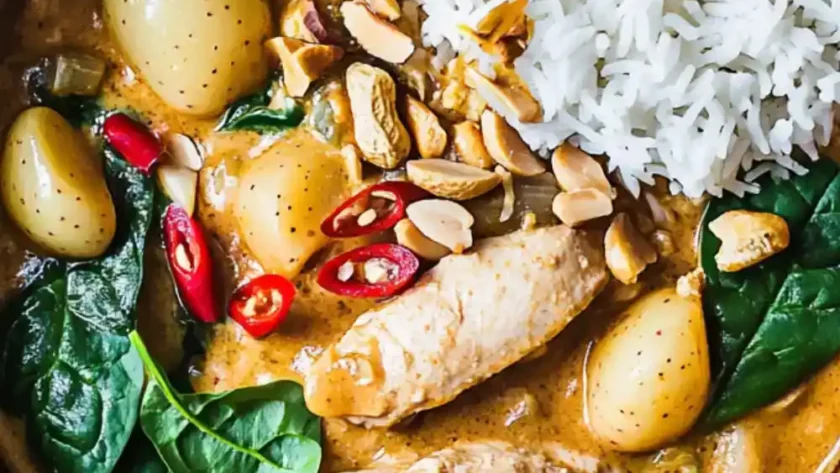This Thai Massaman curry is rich, creamy, and full of warm spices. It’s easy to make with chicken, tofu, or shrimp, plus soft potatoes in a fragrant coconut curry sauce. Serve it over jasmine rice with your favorite toppings for a comforting meal.
Jump to RecipeIngredients Needed:
- 1 ½ pounds Yukon gold or red potatoes, cut into 1 ½-inch chunks
- 1–2 teaspoons coconut oil
- 1 teaspoon coriander seeds
- 1 teaspoon cumin seeds
- 1 medium shallot, thinly sliced
- 2 teaspoons fresh ginger, grated
- ½ teaspoon ground cinnamon
- ½ teaspoon ground cardamom
- ⅛ teaspoon ground cloves
- ⅛ teaspoon ground nutmeg
- 2–6 tablespoons red curry paste (adjust for spice level)
- 2 cans (14 oz each) full-fat coconut milk
- 2 tablespoons fish sauce
- 1–2 tablespoons light brown sugar
- 1–2 tablespoons tamarind puree or paste
- 2 tablespoons peanut butter (optional)
- 1 ½ pounds chicken breast, thinly sliced (or chicken thighs, shrimp, or tofu)
How To Make Massaman Curry Recipe?
- Prepare the ingredients: Get everything ready before cooking. Toss the chicken with ½ teaspoon salt. Keep whole and ground spices separate.
- Parboil the potatoes: Place potatoes in a pot with cold water. Bring to a boil, simmer for 5–7 minutes, then drain and set aside.
- Toast the spices & cook the aromatics: Heat coconut oil in a large pot over medium heat. Add coriander and cumin seeds, stirring for 2 minutes. Stir in shallots and ginger, cooking for 1–2 minutes, then add cinnamon, cardamom, cloves, nutmeg, and curry paste.
- Simmer the coconut milk & potatoes: Pour in coconut milk and add the potatoes. Simmer for 10 minutes until the potatoes are tender but not too soft.
- Season the curry: Stir in fish sauce, brown sugar, tamarind paste, and peanut butter (if using). Mix well.
- Cook the chicken: Add sliced chicken and simmer for 5 minutes until fully cooked.
- Adjust & serve: Taste and adjust seasoning—add more sugar for sweetness, fish sauce for saltiness, or tamarind for tanginess. Serve hot with jasmine rice and toppings.

Recipe Tips:
- Use full-fat coconut milk for the best texture: Light coconut milk can make the curry too thin and less creamy. For a rich, smooth sauce, always use full-fat coconut milk.
- Toast the spices for extra flavor: Heating the coriander and cumin seeds before adding other ingredients releases their natural oils and makes the curry more aromatic. Don’t skip this step!
- Simmer the potatoes just until tender: Overcooking them will make them mushy. Parboil them until they are just fork-tender, as they will continue cooking in the curry.
- Adjust the curry paste based on spice tolerance: Start with less curry paste and add more if needed. Some brands are spicier than others, so taste as you go.
- Balance flavors before serving: Taste the curry at the end and adjust the sweetness (sugar), saltiness (fish sauce), and tanginess (tamarind) to create the perfect balance of flavors.
How To Store & Reheat Leftovers?
- Refrigerate: Let the Massaman Curry cool down before storing it. Put it in an airtight container and keep it in the fridge for up to 3 days.
- Freeze: Once the curry is completely cool, transfer it to a freezer-safe container, leaving some space at the top. Freeze for up to 3 months.
- Reheat: Pour the curry into a pot and warm it over low heat, stirring occasionally. If it’s too thick, add a splash of coconut milk or water to loosen the sauce.
Nutrition Facts:
- Calories: 423 kcal
- Total Fat: 22.9 g
- Saturated Fat: 16.1 g
- Cholesterol: 82.7 mg
- Sodium: 574.7 mg
- Potassium: 701 mg
- Total Carbohydrate: 25.7 g
- Dietary Fiber: 3.6 g
- Sugars: 3.9 g
- Protein: 30.9 g
Try More James Martin Recipes:
James Martin Massaman Curry Recipe
Course: DinnerCuisine: ThaiDifficulty: Easy4
servings15
minutes25
minutes423
kcalThis Thai Massaman curry is rich, creamy, and full of warm spices. It’s easy to make with chicken, tofu, or shrimp, plus soft potatoes in a fragrant coconut curry sauce. Serve it over jasmine rice with your favorite toppings for a comforting meal.
Ingredients
1 ½ pounds Yukon gold or red potatoes, cut into 1 ½-inch chunks
1–2 teaspoons coconut oil
1 teaspoon coriander seeds
1 teaspoon cumin seeds
1 medium shallot, thinly sliced
2 teaspoons fresh ginger, grated
½ teaspoon ground cinnamon
½ teaspoon ground cardamom
⅛ teaspoon ground cloves
⅛ teaspoon ground nutmeg
2–6 tablespoons red curry paste (adjust for spice level)
2 cans (14 oz each) full-fat coconut milk
2 tablespoons fish sauce
1–2 tablespoons light brown sugar
1–2 tablespoons tamarind puree or paste
2 tablespoons peanut butter (optional)
1 ½ pounds chicken breast, thinly sliced (or chicken thighs, shrimp, or tofu)
Directions
- Prepare the ingredients: Get everything ready before cooking. Toss the chicken with ½ teaspoon salt. Keep whole and ground spices separate.
- Parboil the potatoes: Place potatoes in a pot with cold water. Bring to a boil, simmer for 5–7 minutes, then drain and set aside.
- Toast the spices & cook the aromatics: Heat coconut oil in a large pot over medium heat. Add coriander and cumin seeds, stirring for 2 minutes. Stir in shallots and ginger, cooking for 1–2 minutes, then add cinnamon, cardamom, cloves, nutmeg, and curry paste.
- Simmer the coconut milk & potatoes: Pour in coconut milk and add the potatoes. Simmer for 10 minutes until the potatoes are tender but not too soft.
- Season the curry: Stir in fish sauce, brown sugar, tamarind paste, and peanut butter (if using). Mix well.
- Cook the chicken: Add sliced chicken and simmer for 5 minutes until fully cooked.
- Adjust & serve: Taste and adjust seasoning—add more sugar for sweetness, fish sauce for saltiness, or tamarind for tanginess. Serve hot with jasmine rice and toppings.
Notes
- Use full-fat coconut milk for the best texture: Light coconut milk can make the curry too thin and less creamy. For a rich, smooth sauce, always use full-fat coconut milk.
- Toast the spices for extra flavor: Heating the coriander and cumin seeds before adding other ingredients releases their natural oils and makes the curry more aromatic. Don’t skip this step!
- Simmer the potatoes just until tender: Overcooking them will make them mushy. Parboil them until they are just fork-tender, as they will continue cooking in the curry.
- Adjust the curry paste based on spice tolerance: Start with less curry paste and add more if needed. Some brands are spicier than others, so taste as you go.
- Balance flavors before serving: Taste the curry at the end and adjust the sweetness (sugar), saltiness (fish sauce), and tanginess (tamarind) to create the perfect balance of flavors.

